From All Over Turkiye -Tükiye'nin Dört Bir Yanından: Istanbul Archaeological Museums, Hagia Sophia and Nuruosmaniye Mosque (Eng-Tr)
Hello everyone!!! How are you doing? I hope you are well or are trying to be well.
I have officially finished 4 of the 7 regions required for me to be able to do tourism guidance (it must be at least 1). I forgot to mention this detail in the first part of From All Over Turkiye series. Because my memory is very good 😜
Anyway. I'm really travelling all over Turkey, both officially and voluntarily. So far, I have visited 4 regions officially and 5 regions voluntarily. I will continue this series to show you the places I have visited and this will take a really long time. I can say that I will not rest until I show my traces from all over Turkey.
Let's come to the Istanbul stops we will visit with you today. Yes, stops. I thought it would be ridiculous to share them with you one by one. Welcome to our first stop, Istanbul Archaeological Museums, home to the sarcophagus of Alexander the Great and beautiful people!
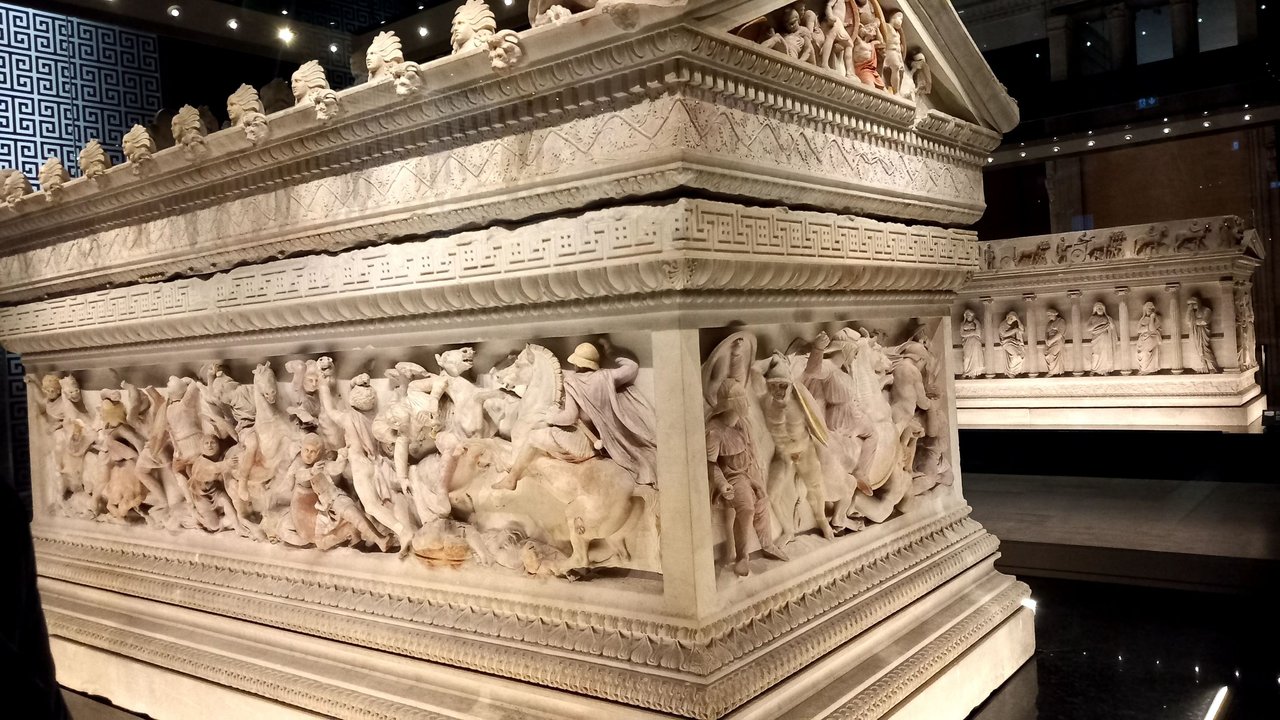
Turkey's oldest building built as a museum is actually home to the sarcophagus of a very important person, as I mentioned above, but it also houses artefacts with a wide range of time intervals that make time flow before our eyes.
As someone who has travelled to 5 regions of Turkey besides Istanbul, I can easily say that it was one of the museums I felt most comfortable in. Everything was almost perfect, from the tone of the lights in which the artefacts were displayed to the cleanliness of the glass boxes.
Since we were moving quickly and I was already in Istanbul, I can't say that I was trying to take detailed photos of everything as we passed by. But I can't say the same for the sarcophagus. I can say that I took detailed photos of this sarcophagus, especially where the colours are still visible.


Although the colour remains, which you can easily see on the right and left, dates back to the last quarter of the 4th century BC, I think they are in very good condition. We can see the red and yellow colours, the colours of the period, with very sharp lines.

I took a photo where we can see the details of the front part a little more easily. So where is this sarcophagus, when was it found, and what is its short history? While talking about these briefly, I would like to proceed inside the museum.

The name of the hall is The King Necropolis of Sydon, but this sarcophagus was found in 1887 in the settlement of the same name in the city of Sydon in Lebanon. In fact, although this date seems very old, after all, we are talking about the 1800s; doesn't it seem like yesterday compared to the history of the necropolis?
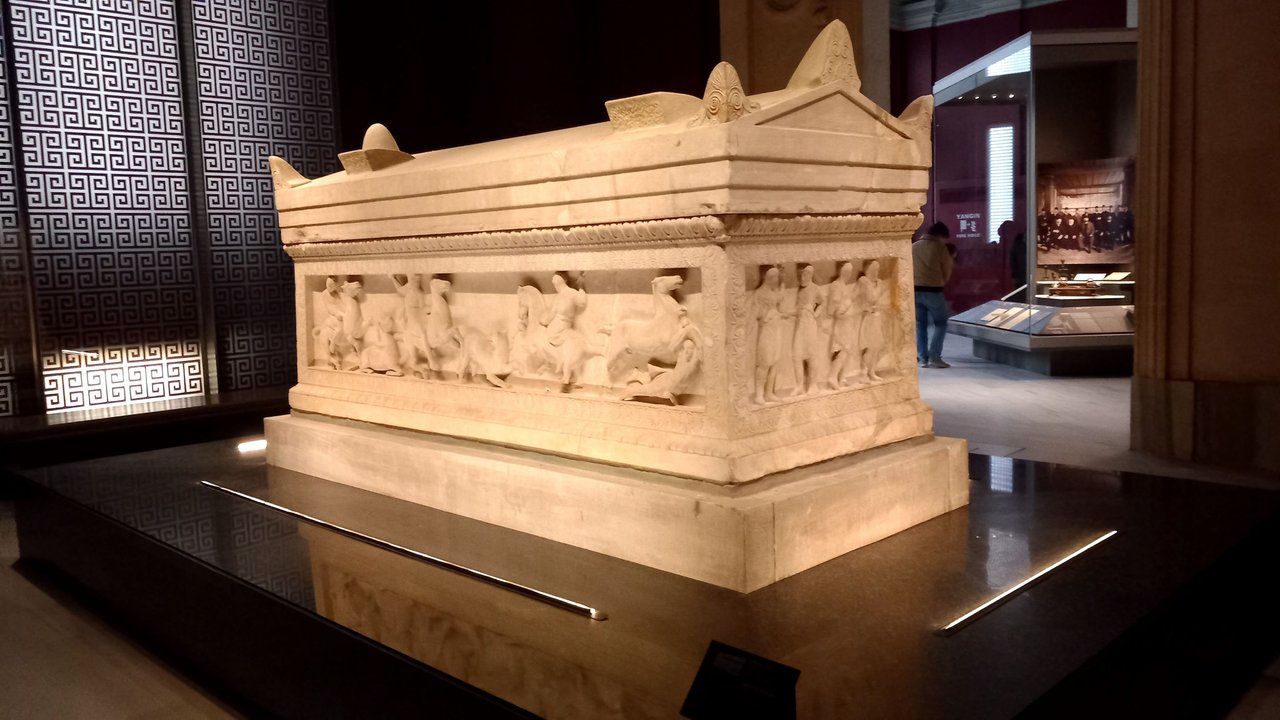
They called the sarcophagus of the satrap a satrap just because it's Persian. It's not clear who it belongs to, of course. It's just scenes from the life of someone they thought was a satrap. It is quite intriguing. Osman Hamdi Bey transported 11 of the 18 sarcophagi discovered in the ancient city of Sydon to Istanbul by ship. He is really a gentleman who has achieved great things.

Now I will share with you a link that I think may be useful for those who cannot visit some museums.
Virtual Museums
On this website you can find and visit some of the famous museums in Turkey.

Now I will talk about 4 important and eye-pleasing works that are not included in the sculpture section, which are in the link I mentioned above, but not all of them are added.

The name of this statue is The Punishment of Marsias. I will not tell the story in detail, but he was punished because he could not play the Phrygian Flute backwards and lost the competition. Marsias is also a satyr. His story is actually quite interesting. Maybe I will share this story with you in the future.

The colossal statue of a divine figure is actually not that big. I'm just kidding. It's much, much bigger than a normal human being. I can't explain on paper exactly what makes this statue special, but you can see for yourself the perfection in the photo.
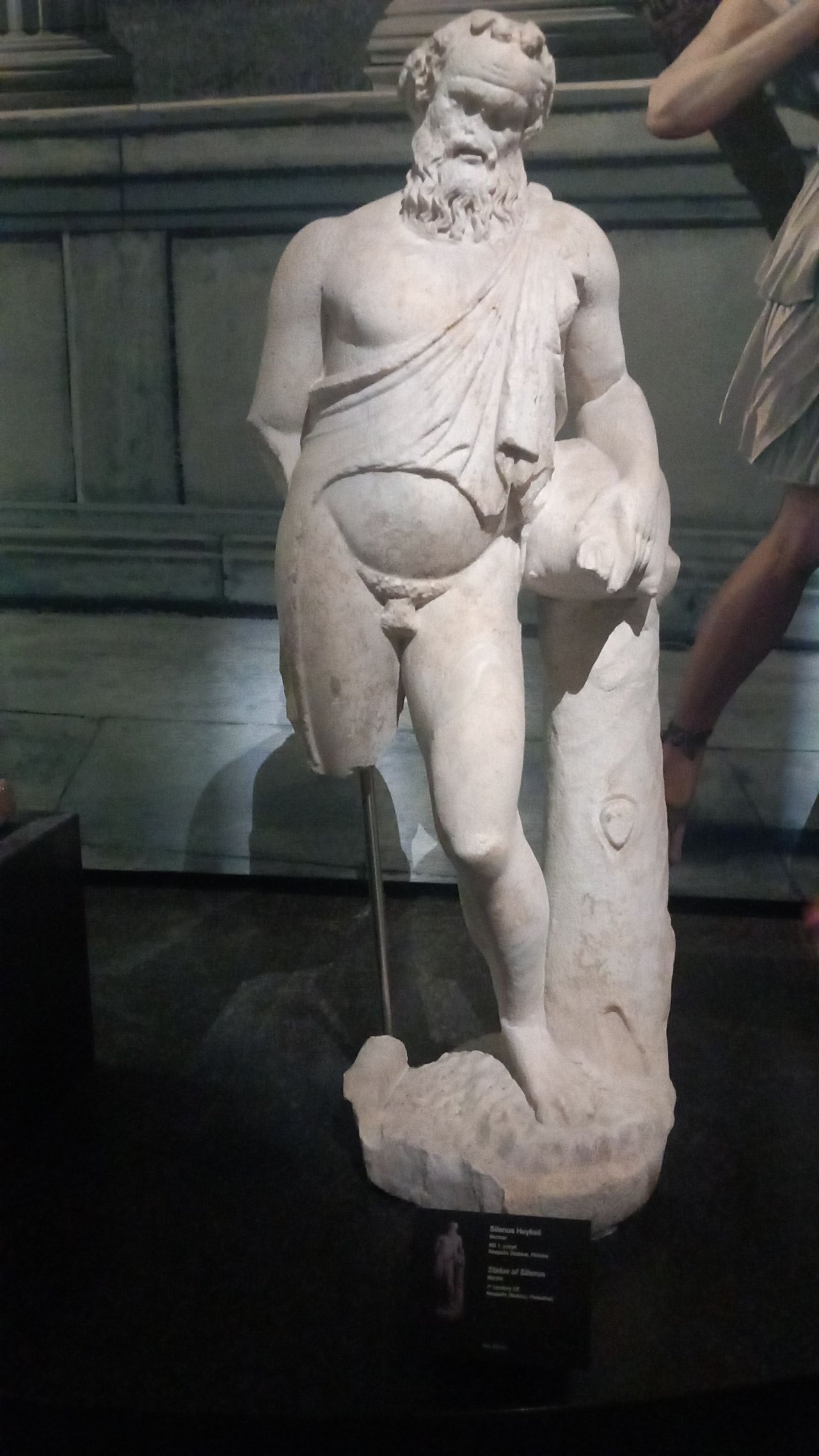
What you see above is an old satyr. In fact, although he does not resemble the satyr type we know, he is the person who trained Dionysus about wine. I don't know if you have noticed, but this statue does not have the beauty of other ancient Greek statues. There are 1-2 reasons for this, but I will tell you the more possible one.
The people living in the north of ancient Greece used to be called Satyrs. Because "civilization" and their main settlements were in the south. In addition, ageing Satyrs, that is, Northern Ancient Greeks, are called Silenos. This statue is also called Silenos.

The statue head above is of Sappho, a famous ancient Greek poet. She is the reason why lyric poetry came to the shores of the Aegean. You can find more information about her in the link I have attached, but I would like to add that it must have been a great woman who made it possible for poetry to develop and change in a country where she was not even considered a citizen.

Thanks to this video map(?), you can watch which natural phenomena took place in Ancient Greece by changing the timeline and location. I was quite impressed by this, frankly. Since I am a visual learner, the more I see, the more it stays in my mind. I can hardly find a better source than this.


At this point, we actually move a little away from Istanbul and go to Çanakkale, to Troy. In fact, in my opinion, this place presented the layers of the ancient city of Troy better than the museum in Çanakkale. A similar artefact there, which I will share in the future, does not have such details and explanations. The Istanbul Archaeological Museums really did a good job.

I have shown you everything I wanted to show you about the Istanbul Archaeological Museums. Next is one of the apples of the Istanbul Historical Peninsula. Hagia Sophia. I have mentioned Hagia Sophia in this post before, but I couldn't get into the interior. Now I want to show you the interior.
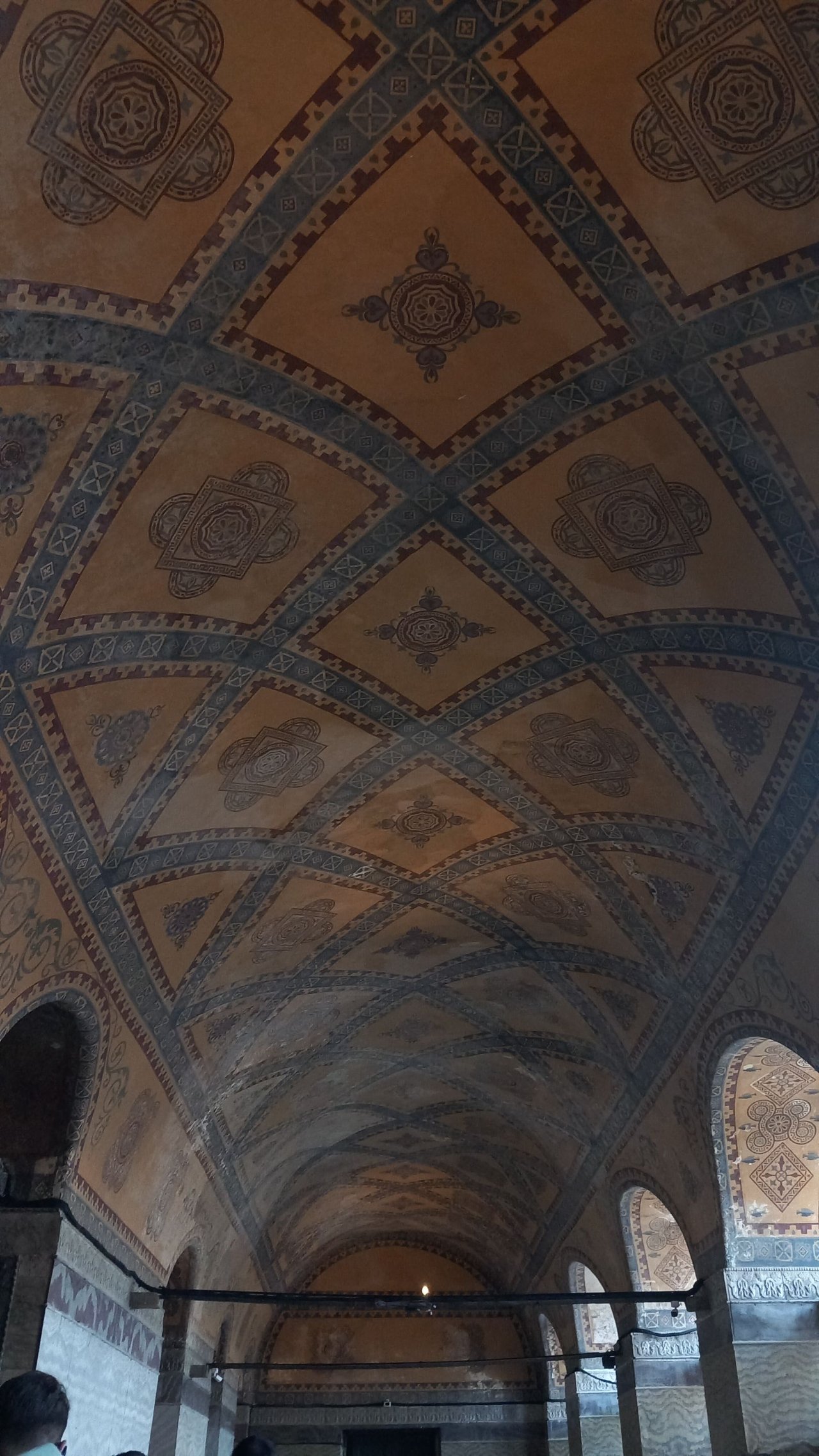
Since Hagia Sophia was opened for worship (...), the lower floor is closed to visitors. As of February 15th, you can go upstairs for a fee of 25 dollars and one of the first things that welcomes you is the embroidery. Although the colours look pale, the embroidery is just as eye-catching, isn't it?
Now I want to show you almost what it is like by adding two videos. Then I will show you the details I like with photos.
I wanted to shoot the downstairs and upstairs individually. I think you can understand my view of this situation in my laughter in the video on the right. Anyway.
Actually, isn't Hagia Sophia a well-known place in the world?


Embroidery, angels, colours and many more look so beautiful together. I wish it wasn't so expensive. 25 dollars is too much for a tourist, local or not. Fortunately, since I was part of the guide group, I was able to get in for free, even if there were difficulties. But if I had to do it myself, I would definitely not be able to or even would not go in. I would never pay for a place I have seen since I was 7 years old in a currency other than my own.
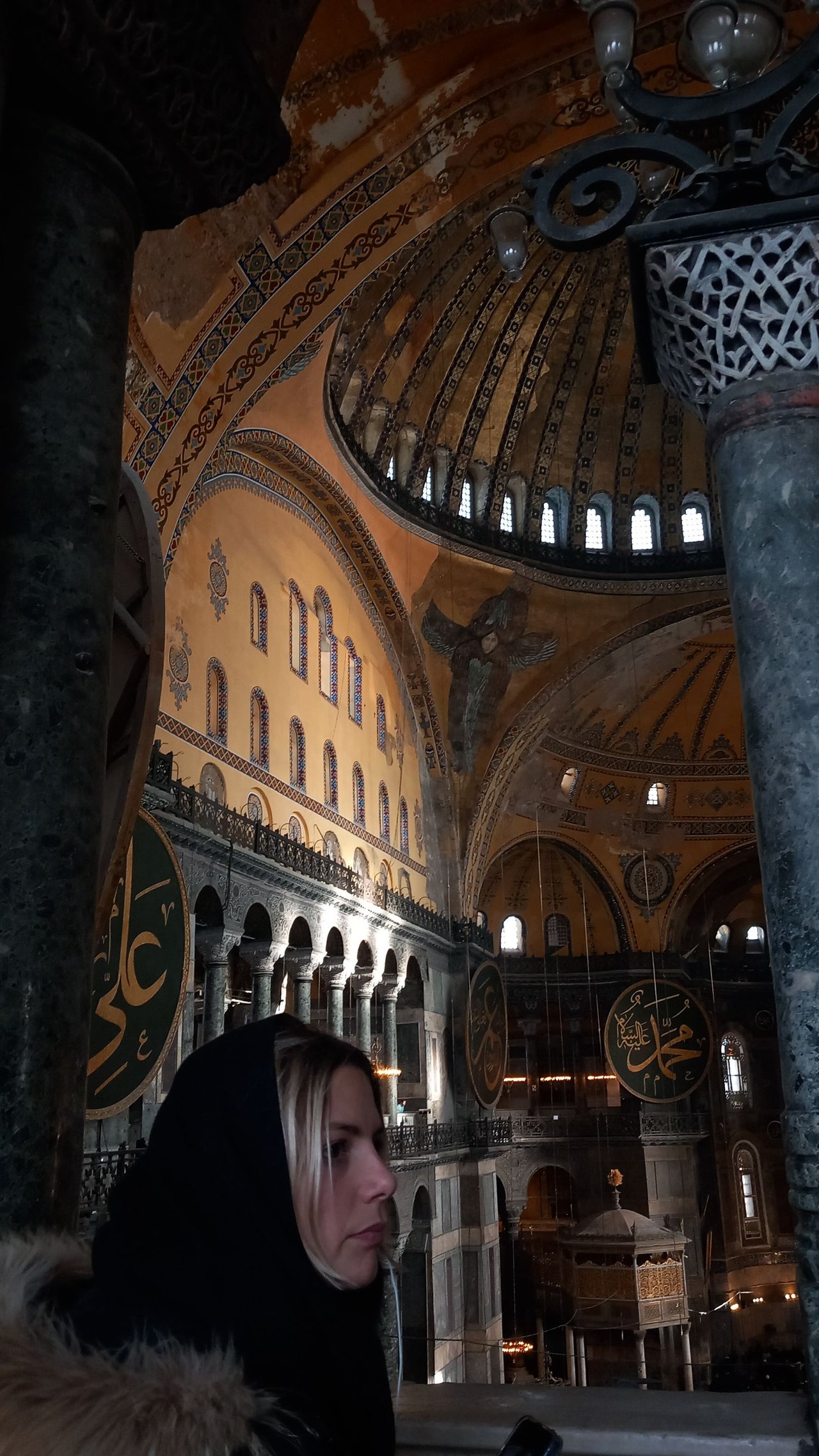
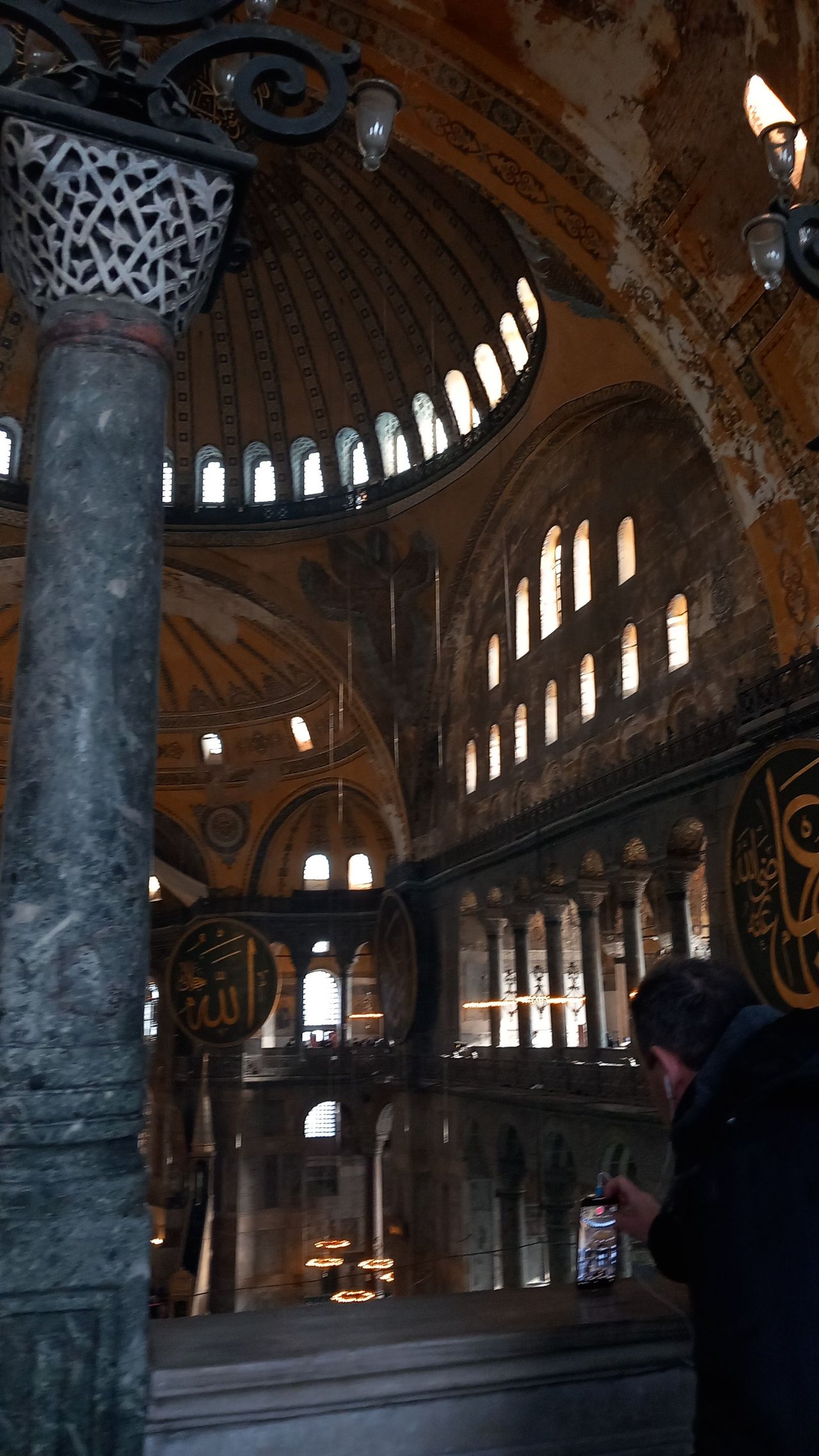
I wish I could examine the details for hours... Especially with the right light, the colours look even more beautiful. Now for the mosaics.
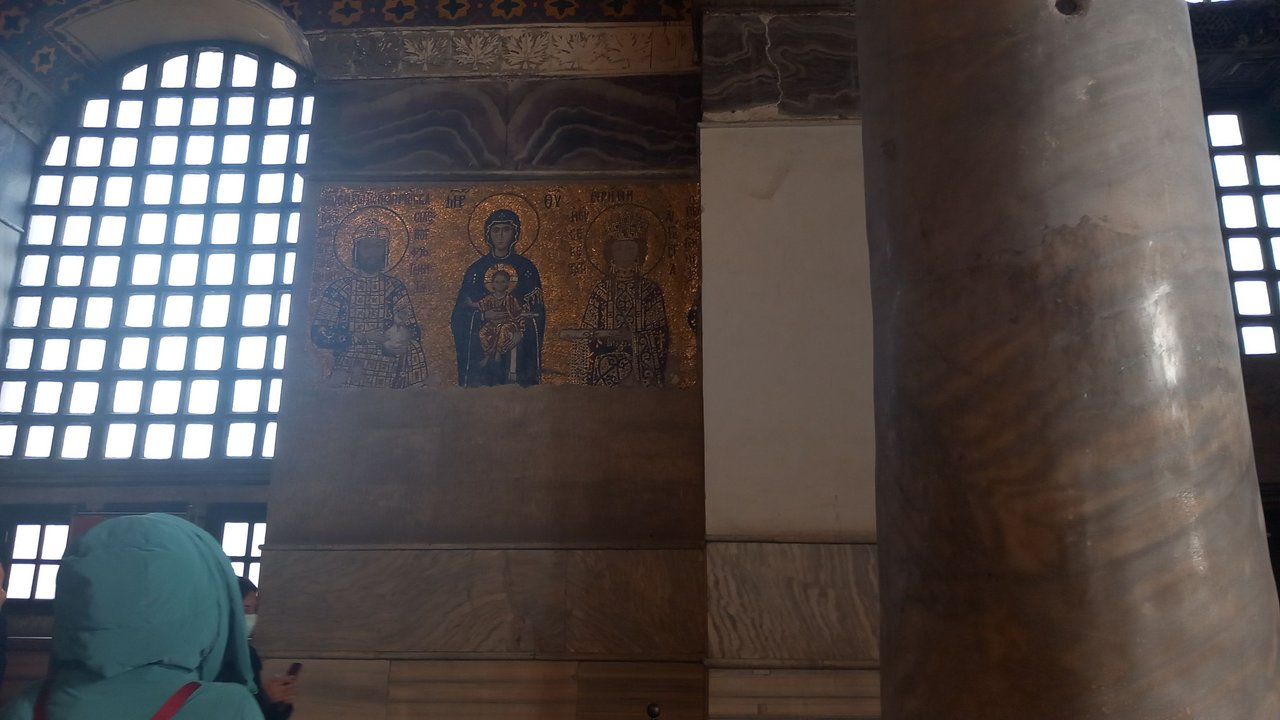
Although the light is very bad, this hasn't lost anything from the gold of this mosaic, has it? By the way, I should add. Women cannot go into the museum without covering their hairs.

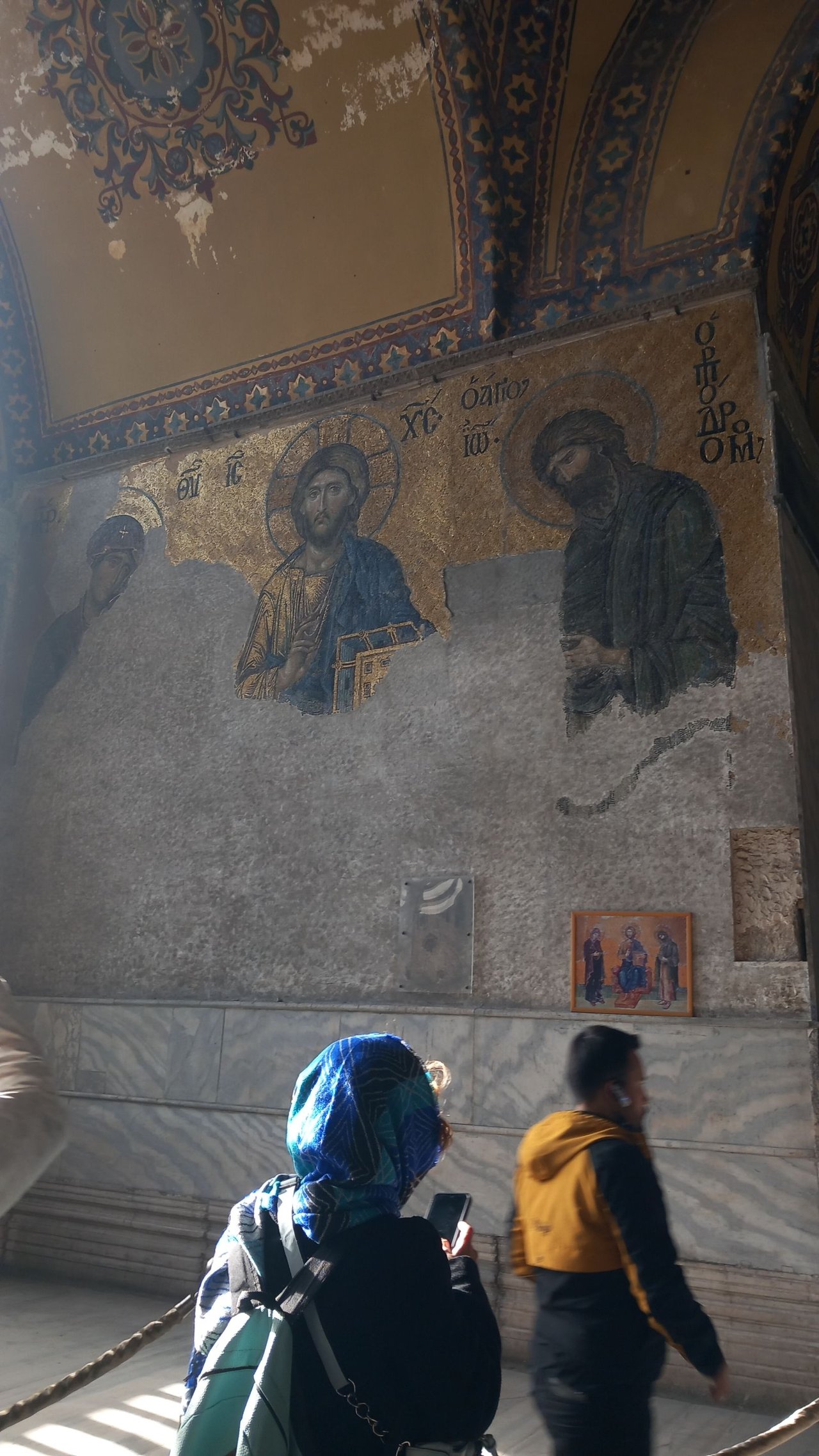

Next is Nuruosmaniye Mosque, the first example of Baroque Architecture in Turkiye. Unfortunately, we couldn't go inside the mosque because of the time. But I was able to take a few photos from the outside, which I quite liked.
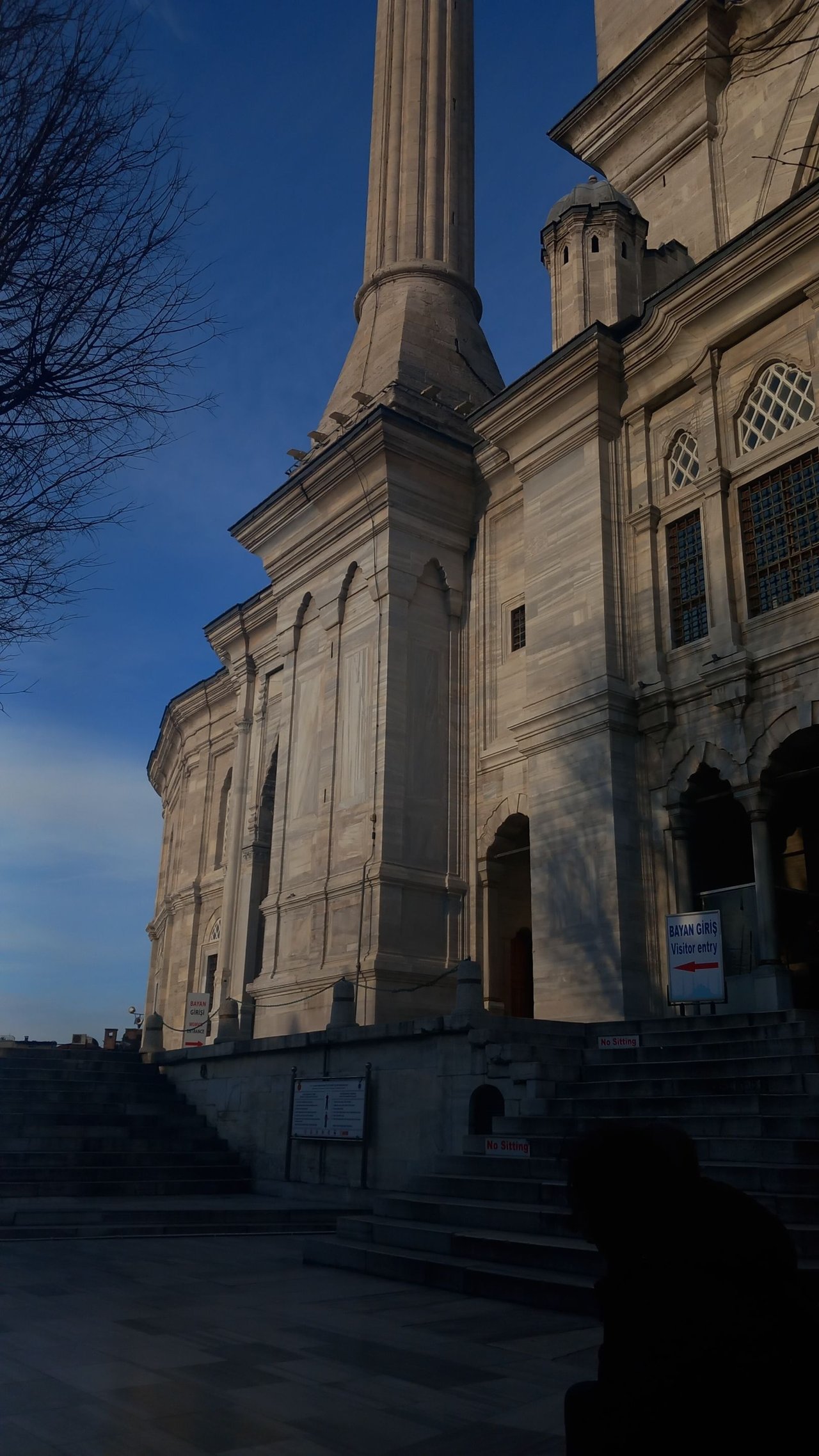
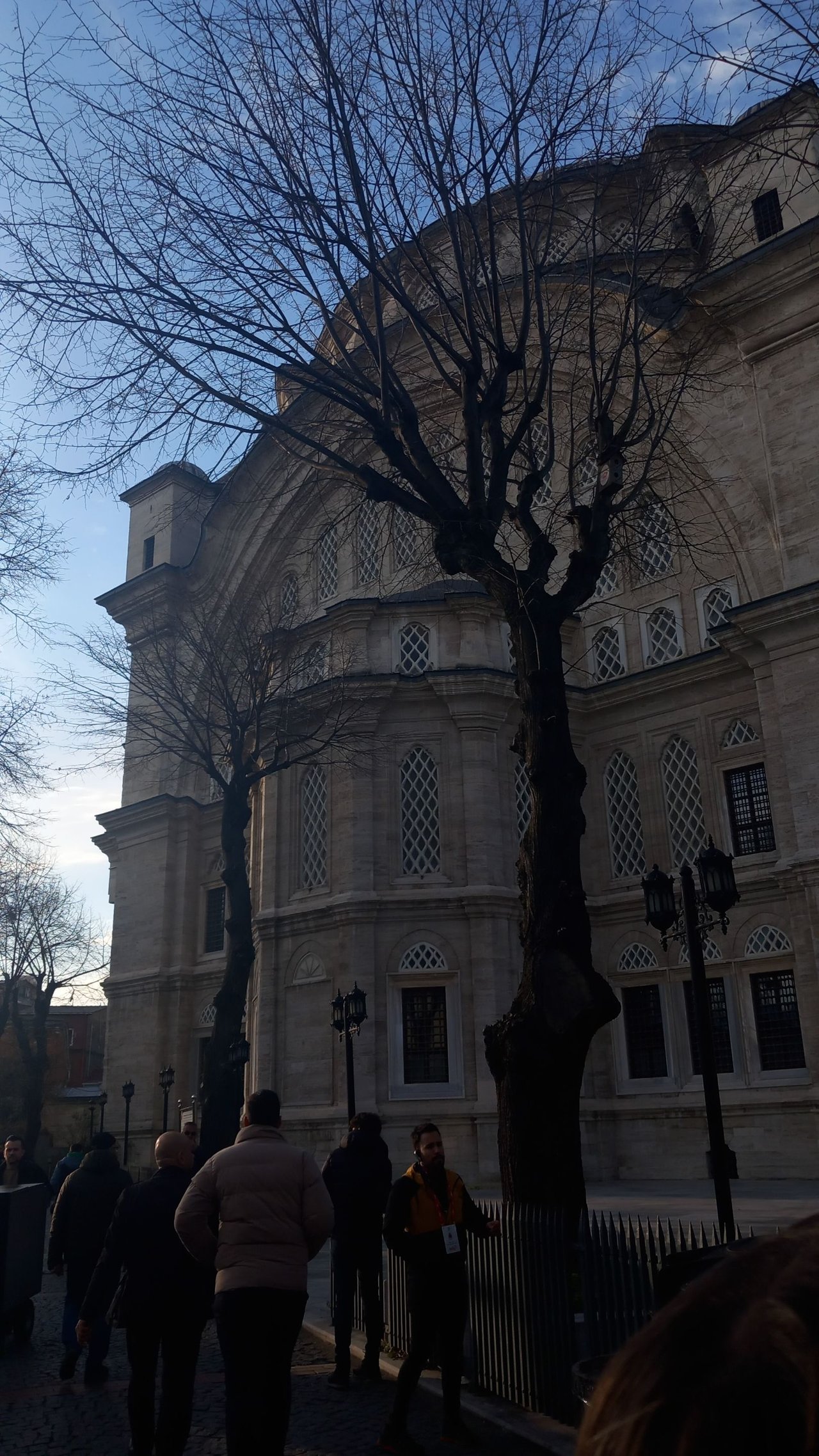
The mosque, which could not be completed after the death of Mahmut I, was completed by Osman III during his 3-year reign. That's why he named it Nur-u Osmani, the Light of the Ottoman Empire. In time, it turns into Nuruosmaniye. It is actually a very beautiful name. Especially when combined with its appearance.

Indeed, this mosque is shining brightly. I like it very much. I wish we had a chance to go inside.

Well, that's all from me for today. I am very happy to be able to walk around Istanbul with you and show you my favourite things, see you on my next trip!
Take care of yourself, stay with health and love and please remember that;
You are the only one of you.


Herkese merhabaaa!!! Nasılsınız? Umarım iyisinizdir ya da iyi olmaya çalışıyorsunuzdur.
Resmi olarak Turizm Rehberliği yapabilmem için gerekli olan (en az 1 olmalı) 7 bölgeden 4'ünü bitirmiş bulunmaktayım. Türkiye'nin Dört Bir Yanından serisinin ilk bölümünde bu detaydan bahsetmeyi unutmuşum. Hafızam çok iyidir çünkü 😜
Neyse. Gerçekten Türkiye'nin dört bir yanını hem resmi olarak hem de kendi isteğimle gezeceğim. Şimdiye kadar resmi olarak 4 ve kendi isteğimle 5 bölgesini gezmiş bulunmaktayım. Size gezdiğim yerleri gösterebilmek için bu seriye devam edeceğim ve bu gerçekten uzun sürecek. Bütün Türkiye'den izlerimi göstermeden rahat etmeyeceğimi söyleyebilirim.
Gelin gelelim bugün sizinle birlikte uğrayacağımız İstanbul duraklarına. Evet, duraklar. Çünkü hepsini teker teker sizinle paylaşmak çok saçma olur diye düşündüm açıkçası. İlk durağımız olan, Büyük İskender'in lahdine ev sahipliği yapan İstanbul Arkeoloji Müzeleri'ne hoş geldiniz güzel insanlar!

Türkiye'nin müze olarak inşa edilen en eski binası aslında yukarıda da bahsettiğim gibi çok önemli birinin lahdine ev sahipliği yapmakla birlikte zamanı gözümüzün önünden aktıracak kadar çok ve geniş zaman aralığına sahip eserleri de barındırıyor.
İstanbul dışında artık Türkiye'nin 5 bölgesini gezmiş biri olarak rahatlıkla söyleyebilirim ki içerisinde en rahat ettiğim müzelerden biri oldu. Eserleri sergiledikleri ışıkların tonundan tutun da cam kutuların temizliğine kadar her şey neredeyse mükemmeldi.
Hızlı bir şekilde ilerlediğimiz ve zaten İstanbul'da olduğumdan geçerken her şeyi detaylı fotoğraflandırmak adına uğraştığımı söyleyemeyeceğim. Fakat lahit için aynısını söylemeyeceğim. Özellikle renklerin hâlâ görülebildiği bu lahidin detaylı fotoğrafını çektiğimi söyleyebilirim.

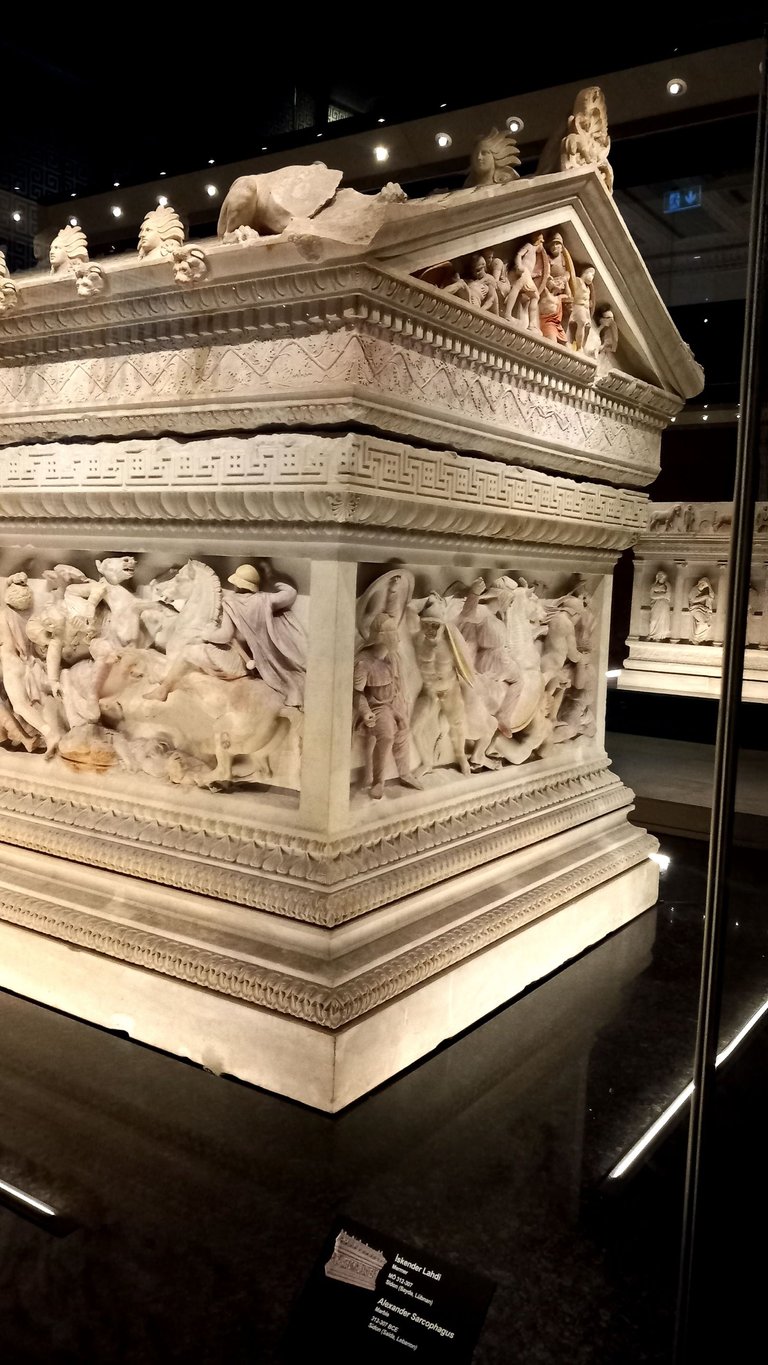
Sağda ve solda da rahatlıkla görebileceğiniz renk kalıntıları MÖ 4. yüzyılın son çeyreğine kadar tarihlenmesine rağmen bence oldukça iyi durumdalar. Kırmızı ve sarı renkleri, dönemin renklerini, oldukça keskin hatları ile görebiliyoruz.

İşte ön kısmın detaylarını biraz daha rahatlıkla görebildiğimiz bir fotoğraf çektim. Peki bu lahit nerede, ne zaman bulundu ve kısa tarihi nedir? Bunlardan kısa bir şekilde bahsederken müze içerisinde ilerlemek istiyorum izninizle.
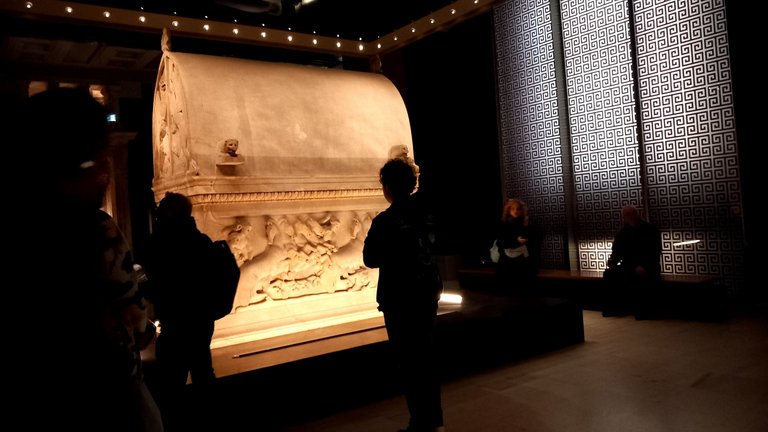
Salonun adı Sidon Kral Nekropolü olmakla birlikte bu lahit 1887 yılında Lübnan'da bulunan Sayda kentinin aynı isimli yerleşiminde bulunmuş. Aslında bu tarih çok eski gibi gelse de, sonuçta 1800'lerden bahsediyoruz, nekropolün tarihinin yanında dünmüş gibi değil mi sizce de?

Satrap Lahdi'ne sırf Pers üslubu olduğundan dolayı satrap adını vermişler.. Kime ait olduğu belli değil elbette. Sadece bir satrap olduğunu düşündükleri birinin hayatından sahneler taşıyor. Oldukça ilginç. Bir de Sayda Antik Kenti'nde bulunan 18 lahdin 11'ini Osman Hamdi Bey gemilerle İstanbul'a getiriyor. Büyük işler başarmış bir beyefendi kendisi gerçekten.

Şimdi size, bazı müzeleri gezemeyecek olanlara faydalı olabileceğini düşündüğüm bir link bırakacağım.
Sanal Müzeler
Bu sitede Türkiye'de bulunan ünlü müzelerin bazılarını bulabilirsiniz ve gezebilirsiniz.

Şimdi ise sırada yukarıda bahsettiğim linkte bulunan fakat tamamının eklenmediği, Heykeltıraşlık, bölümünde bulunmayan 4 önemli ve göze hitap eden eserden bahsedeceğim.

Bu heykelin adı Marsiyas'ın Cezalandırılması hikâyesini uzun uzun anlatmayacağım fakat kendisi Frig Flütü'nü tersten çalamayıp da yarışmayı kaybettiği için cezalandırılıyor. Ayrıca Marsiyas bir satirdir. Hikâyesi aslında oldukça ilgi çekici. Belki ilerleyen bir zamanda bu hikâyeyi sizlerle paylaşırım.
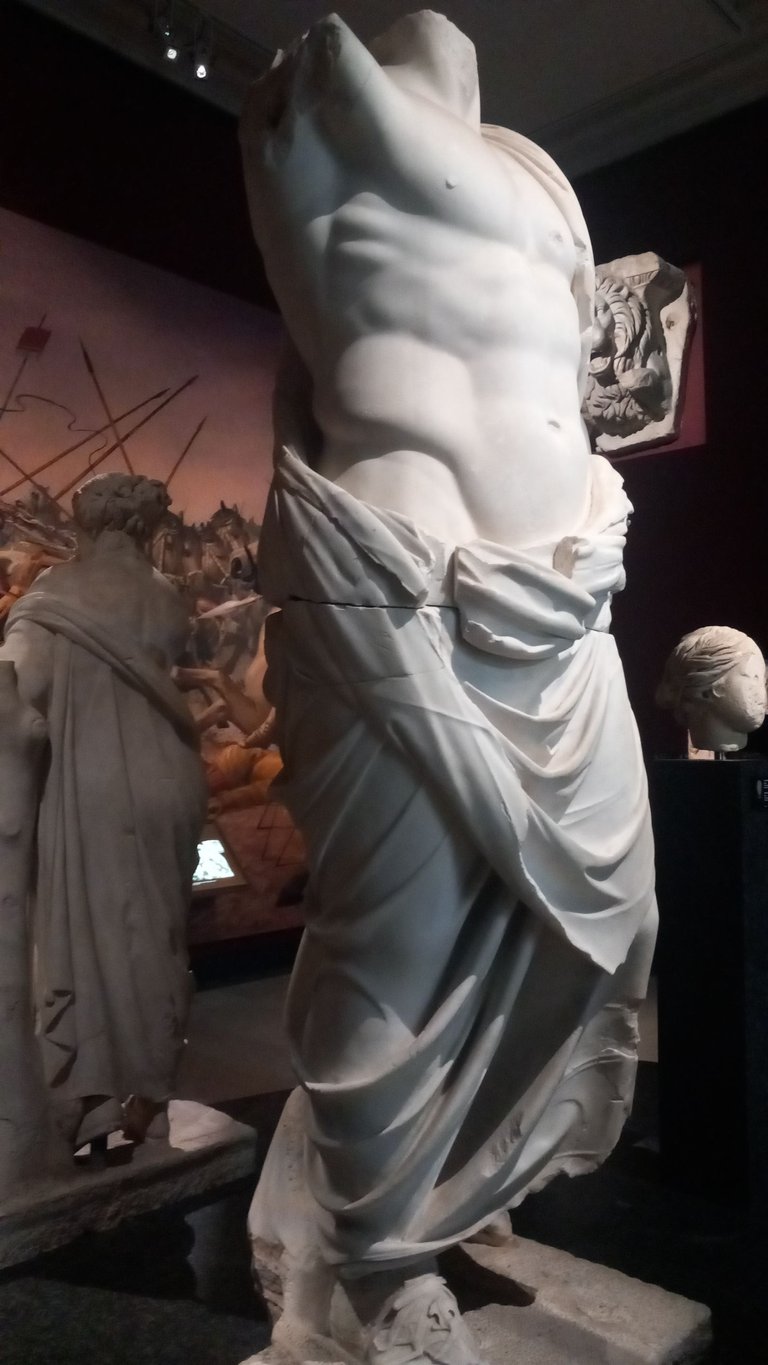
Tanrısal bir figürün devasa heykeli aslında o kadar da devasa değil.. Şaka yapıyorum sadece. Normal bir insandan kat ve kat daha büyük. Bu heykeli özel yapanın ne olduğunu tam olarak kağıt üzerinde açıklayamam fakat fotoğraftaki mükemmelliği kendiniz görebilirsiniz.

Yukarıda gördüğünüz yaşlı bir satir. Aslında bildiğimiz satir tiplemesine benzemese de kendisi Dionysos'u şarap konusunda eğiten kişidir. Fark ettiniz mi bilmem ama bu heykel diğer Antik Yunan heykelleri güzelliğini taşımıyor. Bunun 1-2 sebebi var fakat size daha mümkün olanını söyleyeceğim.
Antik Yunanistan'ın kuzeyinde yaşayan insanlara eskiden Satir diyorlarmış. Çünkü "medeniyet" ve asıl yerleşim yerleri güneyde idi. Ayrıca yaşlanan Satirlere yani Kuzey Antik Yunanlılara, Silenos deniyor. Bu heykelin ismi de Silenos.
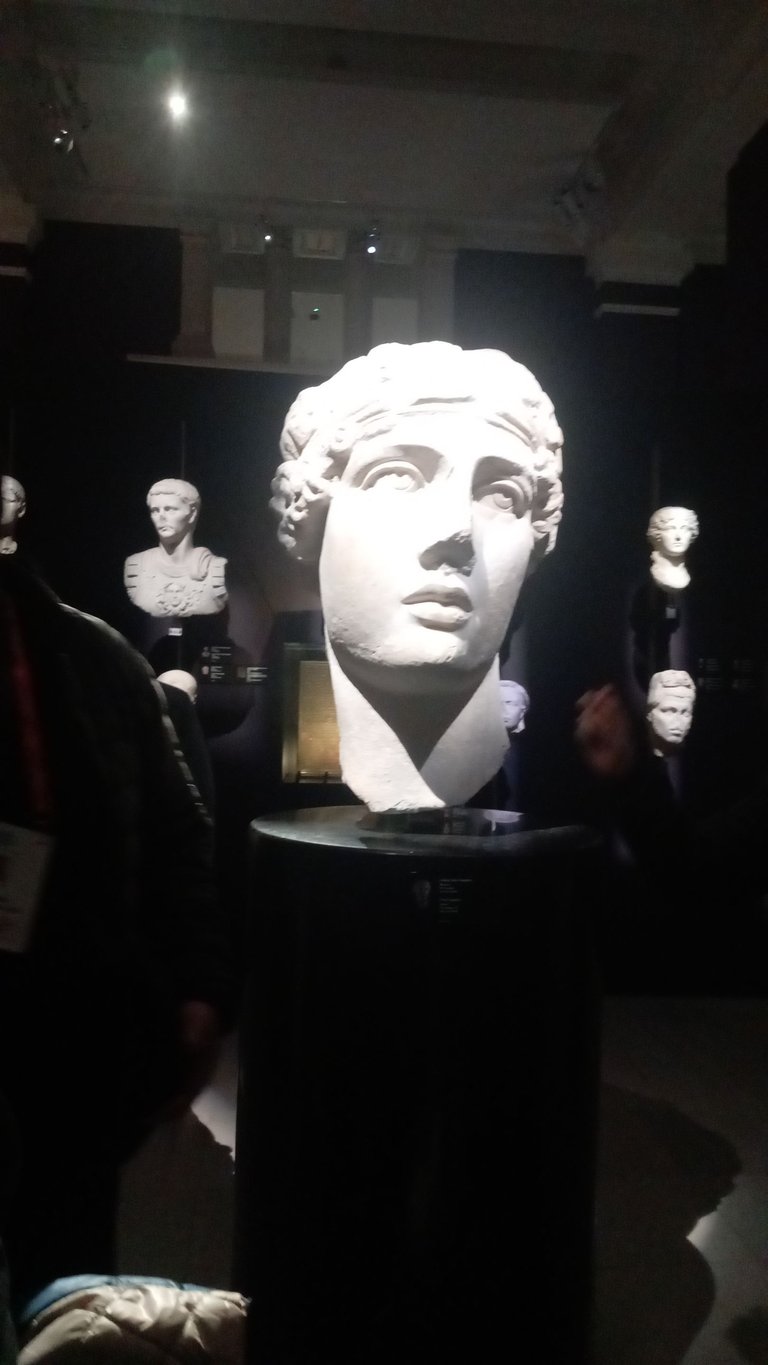
Yukarıdaki heykel başı ünlü bir Antik Yunan şairi olan Sapfo'ya ait. Kendisi lirik şiirin Ege kıyılarına gelme sebebidir. Eklediğim linkte kendisine dair daha fazla bilgi bulabilirsiniz fakat şunu da eklemek isterim ki, vatandaş bile sayılmadığı bir ülkede şiirin gelişmesini ve değişmesini mümkün kılan birisi harika bir kadın olmalı.
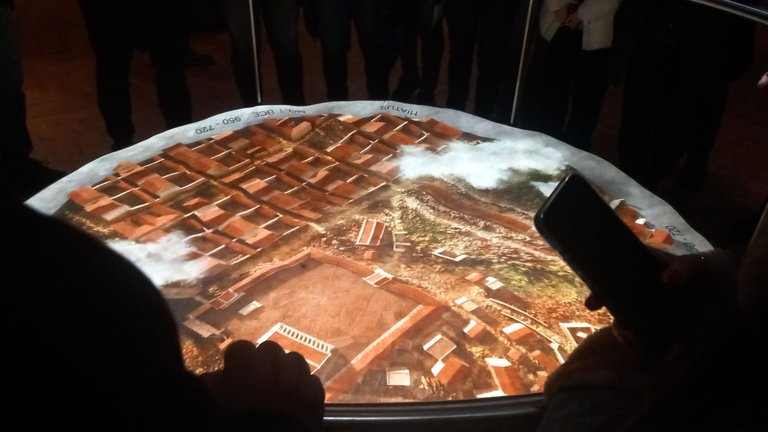
Bu videolu harita(?) sayesinde Antik Yunanistan'da hangi doğa olaylarının olup bittiğini zaman çizelgesini ve konumunu değiştirerek izleyebiliyorsunuz. Bundan oldukça etkilendim açıkçası. Görsel öğrenici olduğumdan dolayı ne kadar çok görürsem o kadar aklımda kalıyor. Bundan daha iyi bir kaynağı zor bulurum.
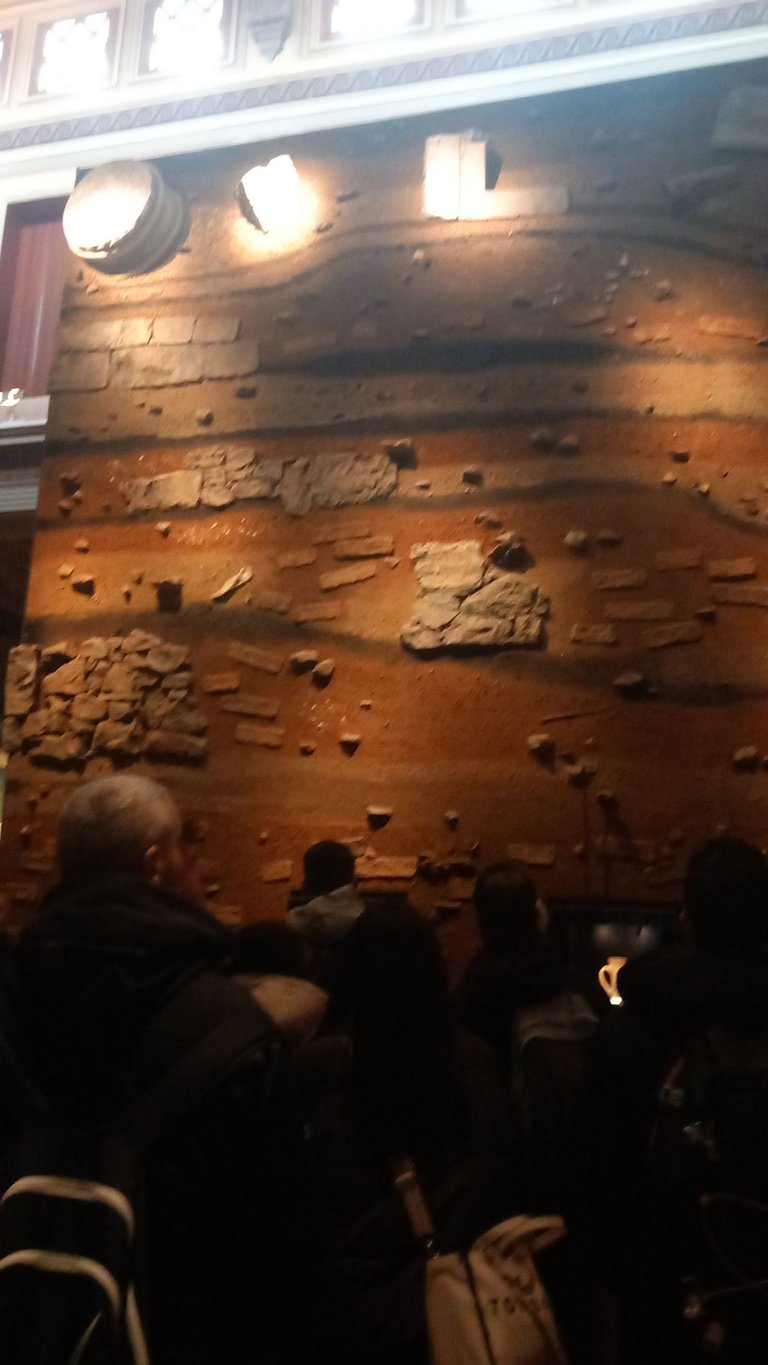
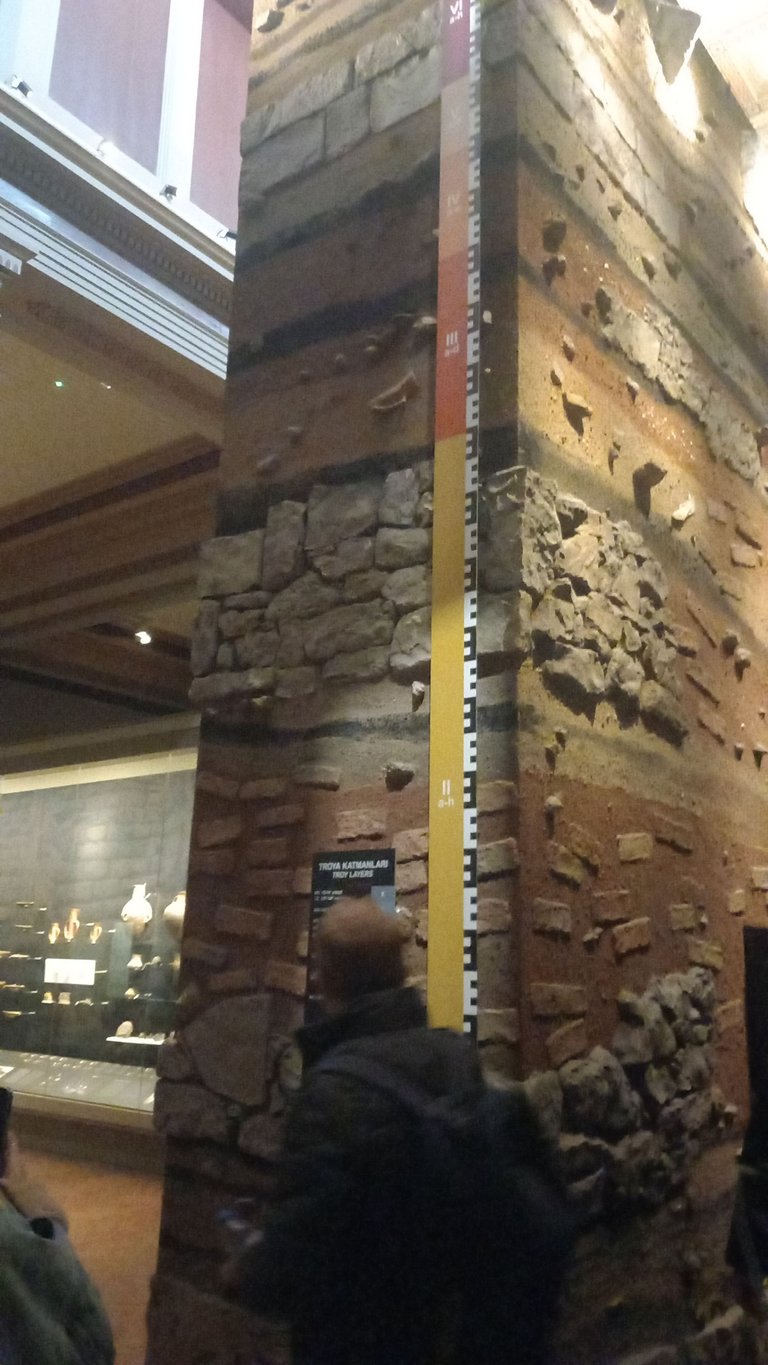
Tam bu noktada aslında İstanbul'dan biraz uzaklaşıp Çanakkale'ye, Troya'ya gidiyoruz. Burası aslında, kendi görüşüm, Troya Antik Kenti'nin katmanlarını Çanakkale'deki müzeden daha iyi sunmuş. Oradaki buna benzer bir eserde, ilerleyen zamanda paylaşacağım, bu kadar detay ve açıklama bulunmuyor. İstanbul Arkeoloji Müzeleri iyi bir iş çıkarmış gerçekten.

İstanbul Arkeoloji Müzeleri ile ilgili size göstermek istediğim her şeyi göstermiş bulunmaktayım. Sırada İstanbul Tarihi Yarımadası'nın gözbebeklerinden biri var. Ayasofya. Daha önce Ayasofya'dan bu postumda bahsetmiştim fakat iç kısmına girememiştim. Şimdi ise size iç kısmını göstermek istiyorum.

Ayasofya, ibadete açıldığından dolayı(...), alt kat ziyarete kapalı. 15 Şubat'tan itibaren ise 25 dolar gibi bir ücret ile üst kata çıkabiliyorsunuz ve sizi karşılayan ilk şeylerden biri bu işlemeler. Renkler her ne kadar solgun görünse de işlemeler bir o kadar göz alıcı değil mi?
Şimdi size, iki video ekleyerek hemen hemen nasıl bir yer olduğunu göstermek istiyorum. Sonra beğendiğim detayları fotoğraf ile göstereceğim.
Alt kat ve üst katı ayrı ayrı çekmek istedim. Sağda bulunan videodaki gülüşümde bu duruma karşı görüşümü anlayabilirsiniz diye düşünüyorum. Neyse.
Aslında Ayasofya dünyaca bilinen bir yer değil mi?

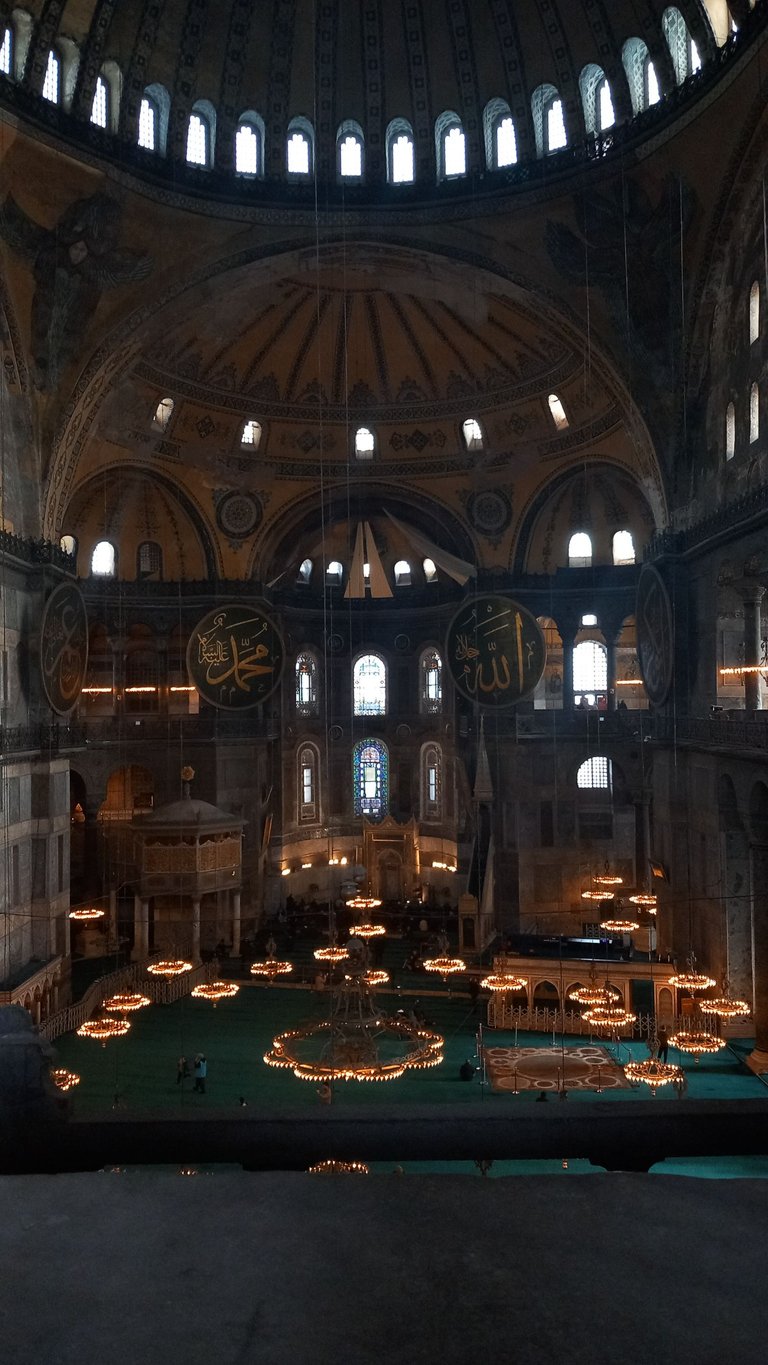
İşlemeler, melekler, renkler ve daha nicesi ne de güzel görünüyor hep birlikte. Keşke bu kadar pahalı olmasa. 25 dolar yerli olsun veya olmasın turist için çok fazla. Neyse ki ben rehber grubuna dahil olduğumdan dolayı, zorluk çıkarsalar dahi, ücretsiz girebildim. Ama kendim girmek zorunda olsaydım kesinlikle giremez hatta girmezdim. 7 yaşımdan beri gördüğüm bir yere kendi para birimim dışında bir birimle ödeme kesinlikle yapmam.


Detayları saatlerce inceleyebilsem keşke... Özellikle doğru ışıkla birlikte renkler daha da bir güzel görünüyor. Şimdi de gelelim mozaiklere.

Işık çok kötü olsa da bu durum bu mozaiğin altınlarından bir şey kaybettirmemiş değil mi? Bu arada eklemeliyim. Müze kısmına da kadınlar başlarını örtmeden giremiyor.
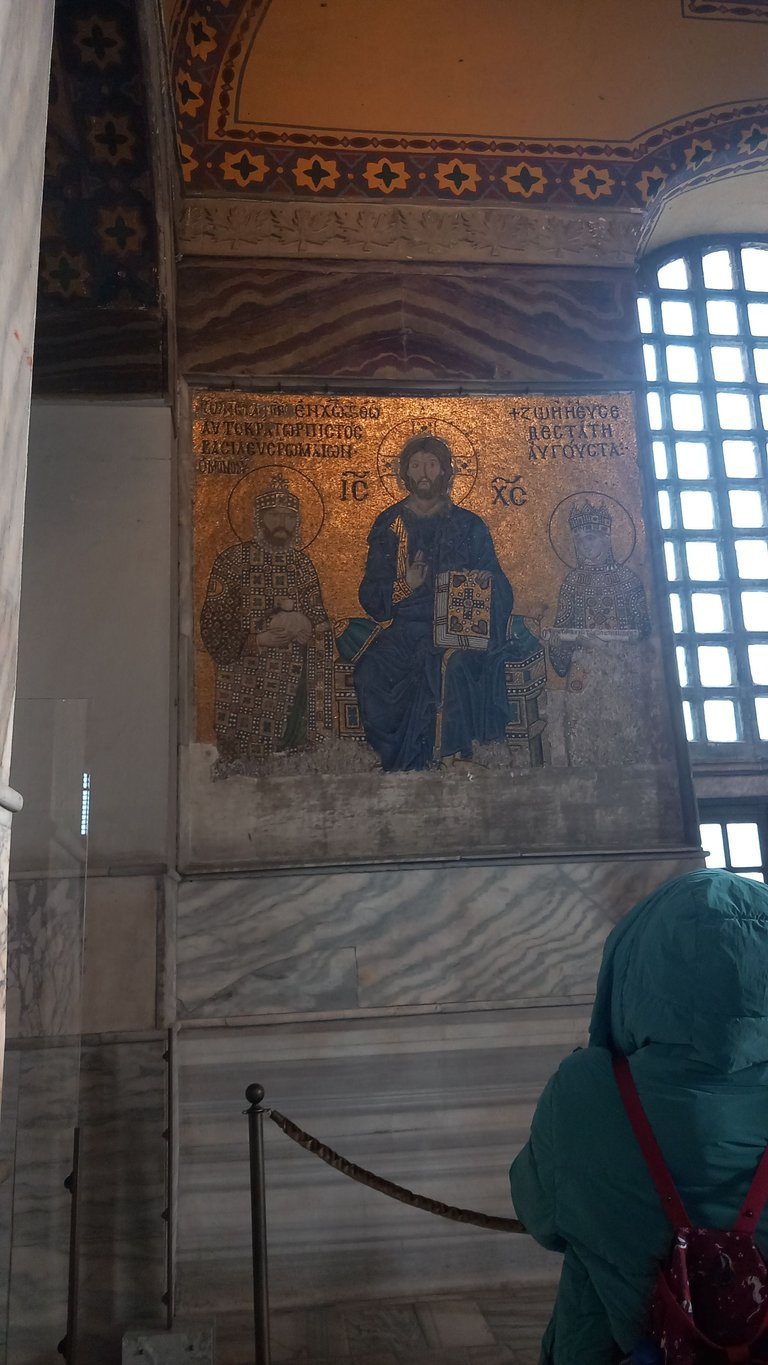


Sırada Barok Mimarisi'nin Türkiye'deki ilk örneği, Nuruosmaniye Camii var. Cami içerisine zaman geçtiği için giremedik ne yazık ki. Ama dışından oldukça beğendiğim birkaç fotoğraf çekebildim.


I. Mahmut'un ölümü ile tamamlanamayan camii 3 yıl süren saltanatı ile, III. Osman tamamlıyor. Bu yüzden de Nur-u Osmani adıyla yani Osmanlı'nın Nuru olarak isimlendiriyor. Zamanla da Nuruosmaniye'ye dönüşüyor. Oldukça güzel bir isim aslında. Özellikle de görüntüsü ile birleşince.

Gerçekten de nur gibi ışıl ışıl parlıyor bu camii. Benim çok hoşuma gitti. Keşke içeri girebilme şansımız olsaydı.

Eveett, bugünlük de benden bu kadar. İstanbul'da sizinle biraz dolaşabildiğim ve beğendiğim şeyleri gösterebildiğim için çok mutluyum bir sonraki gezimde görüşmek üzere!
Kendinize dikkat edin, sağlıkla ve sevgiyle kalın ve lütfen unutmayın ki;
Bu dünyada sizden başka bir tane daha yok.

Bütün fotoğraflar aksini iddia etmediğim sürece benim tarafımdan, akıllı telefonumla çekilmiştir.
All photos are taken by me, with my smart phone unless otherwise stated.
All of my content is written in Turkish first and then with the help of translators and dictionaries below translated in English.
https://www.seslisozluk.net
https://www.deepl.com/translator
P.S. If you know English AND Turkish, I do that too... If you see a translation discrepancy that was on purpose. I did think this is as proper as I could do. Because there are many differences between these languages.
Not: Hem Türkçe hem de İngilizce biliyorsanız, ben de biliyorum... Eğer çeviri farklılığı görürseniz bunun bilinçli olduğunu bilin lütfen. Bunu yapabileceğim en uygun şekilde yaptığımı düşünüyorum. Çünkü bu iki dil arasında çok fazla fark var.
Congratulations, your post has been added to Pinmapple! 🎉🥳🍍
Did you know you have your own profile map?
And every post has their own map too!
Want to have your post on the map too?
Hiya, @ybanezkim26 here, just swinging by to let you know that this post made it into our Honorable Mentions in Travel Digest #2174.
Your post has been manually curated by the @pinmapple team. If you like what we're doing, please drop by to check out all the rest of today's great posts and consider supporting other authors like yourself and us so we can keep the project going!
Become part of our travel community:
lahitteki detaylar ilgi çekici, bayağı detaylı fotoğraflamışsın, ellerine sağlık 👏
bu konuda haklısın, aynı fikirdeyim, o kadar saçma ki :/
bu camiyi ben de çok beğeniyorum, içine girip göremedim ama dışından muhteşem görünüyor
güzel ve keyifli bir geziydi, sayende bazı detayları da görmüş oldum, ayaklarına sağlık:)
yeni yerleri anlatacağın yazılarını merakla bekliyorum ✨️